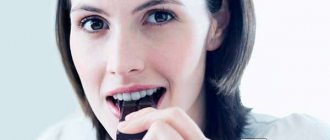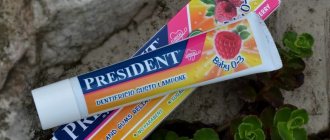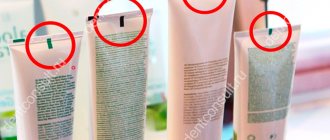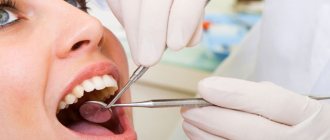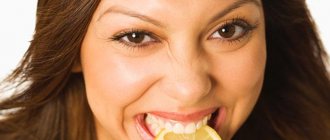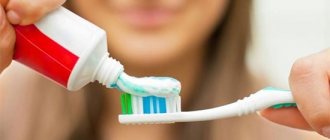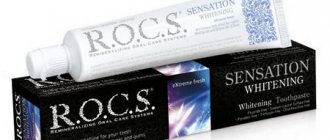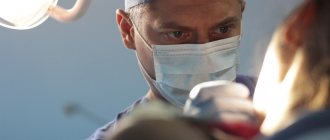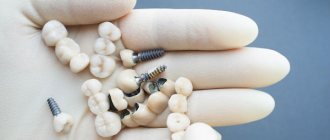When to use calcium toothpaste
Specialized hygiene products with medicinal properties should be used on the recommendation of a doctor, when necessary. Pastes with calcium are used for demineralization of enamel and susceptibility to caries. They help with increased sensitivity of teeth and the presence of small cracks in them.
Calcium paste is also useful for caries in the spot stage, when remineralization is carried out by the dentist. This remedy helps with the tendency to form hard plaque.
Calcium-containing pastes can be used both at the treatment stage and for the purpose of prevention. They can be used periodically in small courses.
What are abrasives and why are they included in toothpastes?
The main task of toothpastes is to combat plaque that accumulates on the surface of teeth, which over time can mineralize and turn into tartar. That is why most pastes, especially whitening ones, contain abrasives, that is, substances that have high hardness and are used for grinding and polishing various materials. Abrasives (or cleaning and polishing agents) typically make up 40-50% of the contents of a toothpaste and are therefore often referred to as the base. The operating principle of most of these substances is based on abrasive abrasion of colored plaque. This is similar to cleaning a frying pan with a special brush: toothpaste “scratch” plaque due to abrasive components, gradually removing it. The advantage of this method lies in its high efficiency - with a high abrasiveness of the paste, you can lighten your teeth in literally a matter of days. The main disadvantage of the method is damage to the enamel itself by abrasive particles - simply put, when plaque is removed mechanically, the enamel is also erased. In turn, this can lead to various dental problems, the most obvious of which is their increased sensitivity to various irritants - for example, cold and hard foods.
Toothpastes with calcium for adults
President Unique is a fluoride-free paste that is designed specifically for people who live in regions with high levels of this substance in water. The product is hygienic. The composition is aimed at restoring the balance of minerals in the enamel. With regular use, you may notice a decrease in tooth sensitivity.
Cedar balm with calcium is a paste that is well suited for hyperesthesia. It contains calcium glycerophosphate, which is needed to protect against caries and strengthen teeth. The paste also includes plant components with antiseptic and bactericidal effects. It effectively eliminates bad breath and prevents the growth of bacteria.
ROCS Active calcium is a xylitol-based paste that strengthens enamel and reduces its sensitivity. The product has low abrasiveness. The active component, with regular use of the paste, restores damaged tissue. It also prevents the development of caries by neutralizing the acidic environment during cleaning.
Other effective pastes containing calcium:
- Splat Biocalcium. Strengthens hard tooth tissues and reduces sensitivity, which can be noticed after just a few days of use. The paste normalizes acidity in the oral cavity and has a positive effect on the gums. In addition, a whitening effect is noted.
- New Pearl Calcium. Paste for delicate cleaning. It freshens breath well, strengthens teeth, and promotes enamel mineralization. Prevents the accumulation of hard deposits and serves as a prevention of frequent dental diseases.
- Biomed Calcimax. Designed for safe and comprehensive oral care. With regular use, it prevents caries. Good breath freshener. It has an anti-inflammatory, anti-caries, strengthening effect, stimulates blood circulation to prevent gum disease.
- Lakalut Multi-Effect. Paste for comprehensive oral care. The product helps restore enamel and protect against demineralization. When used regularly, the paste copes with increased sensitivity. It has a pleasant taste and freshens breath for a long time. A well-balanced composition includes calcium lactate, hydroxyapatite, phosphates, zinc chloride, aluminum lactate, sodium fluoride.
- Dabur Promise with fluoride and calcium. The product additionally contains herbal components that have a positive effect on the gums, preventing inflammation and bleeding. The paste has a complex effect on teeth and mucous membranes. Effectively and carefully removes plaque, preventing its mineralization and the formation of stones.
- 32 pearls Ca. It has good cleansing properties and can be used to prevent plaque and better remineralize enamel.
- Sensodyne Recovery and protection. Whitening paste with calcium to reduce sensitivity and prevent caries. The composition contains sodium fluoride, which, together with Novamin technology, creates a protective film on the surface of the crown, similar in structure to natural tissue. Can be used for daily hygiene.
Healthy
- Make sure that the toothpaste that will protect the enamel contains either fluoride or calcium. Together they are active.
- In order for toothpaste to strengthen, protect and restore enamel, it should not contain peroxide, chlorhexidine, triclosan, sodium lauryl sulfate, or saccharin.
- To strengthen or restore enamel, it is not enough just to purchase toothpaste. It also needs to be applied correctly. At least 3 times a day and for at least 3 minutes. This is the time it takes for the active ingredients of the paste to begin to act.
- Don't ruin your pasta's work by eating unhealthy foods. Say no to sweet sodas, sweets, strong tea and coffee.
- If toothpaste does not cope with the task and symptoms of enamel damage still appear, be sure to consult your dentist for advice. You may need professional dental procedures to strengthen and restore the enamel.
Toothpastes with calcium for children
Hygiene products with calcium are recommended to be used only in adolescence, when necessary. To clean baby teeth, calcium-containing toothpastes should be prescribed by a dentist.
ROCS Kids is a low abrasive product for gentle cleaning. Xylitol with calcium glycerophosphate has a positive effect on enamel, preventing the occurrence of caries. The composition contains plant extracts that are needed for the prevention and treatment of bleeding. They also reduce pain from existing gum disease.
SILCA Putzi is a hygienic paste intended for children over 2 years old. It has a pleasant taste for children. The composition contains only natural ingredients, including calcium-containing ones. Vitamin E has a positive effect on the mucous membrane.
Splat Baby - contains dicalcium phosphate dihydrate, which destroys plaque, preventing the formation of hard stone. During cleaning, a protective layer is created on the enamel. The paste is positioned as a dental care product for little ones.
Antibiotics...in toothpaste?
The antibiotic triclosan, which is part of the most popular toothpastes, can be no less dangerous than fluoride. This antibiotic is added to kill harmful germs and bacteria in the mouth.
However, triclosan destroys not only pathogenic organisms, but also beneficial bacteria and microbes in the mouth.
In this case, harmful bacteria appear again, and useful bacteria, those that fight harmful microorganisms, may disappear altogether.
Pastes with biocalcium
DIES Biocalcium is a paste with calcium-containing elements for professional whitening. Papain penetrates the plaque, destroying it, after which it is cleaned off with abrasive components. Fish oil promotes good calcium absorption.
Crimean herbalist Biocalcium is a hygienic paste for the prevention of caries. Vitamin D promotes better absorption of calcium-containing elements. The mineral bischofite prevents the breakdown of calcium in the enamel by inhibiting the development of microorganisms that contribute to this. The plant substances in the composition help prevent periodontal diseases and eliminate bleeding gums.
Harmful ingredients in toothpastes
When buying toothpaste, you must definitely look at its composition and the order of the ingredients - the closer the component is to the beginning of the list, the more of it there is in the product. Harmful substances in toothpaste - list:
- Sodium lauryl sulfate (SLS), sodium laureth sulfate (SLES)
are surfactants that produce thick foam. Surfactants have a very aggressive effect on the body, and when used in toothpaste they are doubly harmful. Surfactants destroy cells, which leads to weakening of the body, allergies and even Alzheimer's disease. - Sodium coco sulfate (SCS)
is a surfactant similar in origin and composition to SLS. It is believed that this substance is less toxic, but in reality it differs little from sodium lauryl sulfate, although SCS is often included in toothpastes advertised as an eco-product. - Fluorine
is a component from the category of “we treat one thing, we cripple another.” Fluoride is useful for preventing caries, but its excess leads to the destruction of bone and joint tissue, the formation of kidney stones and other serious problems. There is not much of this element in pasta, but fluorine is also found in many products, and in some regions - in water, which ultimately leads to an overdose. Fluorine in the product can be hidden under other names - tin fluoride, sodium fluoride, monofluorophosphate, amino fluoride. - Triclosan
is a strong antibiotic that destroys not only harmful, but also beneficial microflora. Chlorhexine, metronidazole, formaldehyde, propylene glycol and other components can be added to toothpaste as an antibiotic. With prolonged use of pastes with antibiotics, the oral microflora dies completely, which leads to an imbalance in the body. - Aluminum lactate
– one of the aluminum salts, is an anti-inflammatory component, reduces tooth sensitivity and bleeding gums. The harm of aluminum lactate is that it is absorbed and accumulates in the body, causing problems in the brain - memory loss, Alzheimer's disease, etc. In addition, aluminum salts remove calcium, disrupt hemoglobin synthesis, and provoke problems with joints and bones.
In addition to those already described, toothpaste often contains controversial components that can lead to problems. These substances include:
- glucosides, for example, coco glucoside, decyl glucoside, sodium lauryl sarcosinate, cocamidopropyl betaine - soft anionic surfactants;
- titanium dioxide – clarifier;
- saccharin is a synthetic sweetener that many doctors consider carcinogenic;
- sodium carboxymethylcellulose (sodium CMC) is a stabilizer that causes allergies, stomach upsets and other problems.
The harm of toothpastes! Detailed analysis of the composition. How to brush your teeth?
Before, I also never thought about what I use to brush my teeth—paste and paste, it cleans my teeth, what else do I need? And then I watched a video about modern toothpastes in the context of their impact on health and, impressed, began to further study the information on this issue. And then the other side of a beautiful tube of toothpaste . Since then, I have stopped using toothpastes... or rather mass-produced toothpastes. But don’t be alarmed, I continue to brush my teeth, and my hygiene is fine)))
By the way, many people think that if you delve into the composition of all food products, shampoos, creams, toothpastes, washing powders, etc. ... then everything, absolutely everything will turn out to be harmful! And you will have to give up everything. All that remains is to go into the forest - drink rainwater, eat the energy of the sun, brush your teeth with banana skins and wash with burdocks))) Therefore, it is better not to bother at all with health issues and live as you live. This is a position, and it has a right to exist. But I have a different approach, and I never tire of telling you that it is very simple - to live taking care of your health! There are a lot of useful products that are also convenient and pleasant to use! Over time, I have created a list of stores for myself where I buy everything I need - healthy food, cosmetics, etc. Of course, there are people who do it all with their own hands (like brushing your teeth with banana skins), but I live in a big city and I have no desire to turn a healthy lifestyle into fanaticism. From my point of view, all this (food, shampoos, pastes...) should be in the background. This is not what we live for. The main thing is to set goals, realize your talents, look for activities and people you like) So this is a big myth - that all vegans are fanatics, obsessed with food and choosing the right shampoo!
But let's get back to toothpastes. In this article I want to share with you what information I found about toothpastes:
- What is included in toothpaste?
- What could be the health risks of toothpaste?
- Is there such a thing as safe toothpaste? How to brush your teeth?
COMPOSITION OF TOOTH PASTE
In general, it is enough to look with the eyes of a layman at the composition of a standard toothpaste to understand that something is wrong here... Reminds me of a chemistry lesson - some incomprehensible chemical compounds. It is unlikely that you will be able to find anything natural there, and if there is any chamomile extract, it will be in last place with a share of 0.001%. This alone tells me that I don’t need such a paste. If I don’t understand what it consists of, then it turns out that I have to blindly trust the manufacturer... Somehow I don’t feel comfortable trusting Procter&Gamble, to be honest))) I can trust myself and my knowledge, or a loved one, but I can trust that that a giant industrial company took care of my health... it's a bit too much.
But this is an intuitive opinion. And we need facts, facts, facts...))) Let's see what toothpaste consists of and what it can mean:
Sodium lauryl sulfate (SLS).
Available in 99% of toothpastes on shelves, including premium format toothpastes (for example, Splat and Lacalut).
Sodium lauryl sulfate is the same as A-surfactant - anionic surfactants. I wrote in detail about A-surfactants in an article about the dangers of washing powders. Yes, yes, A-surfactants are included not only in most washing powders and detergents, but also in toothpaste! They are responsible for foaming and quickly removing stains. It is due to sodium lauryl sulfate that pastes foam so well and instantly clean teeth.
Attention! In addition to pastes, sodium lauryl sulfate is included in shampoos, shower gels, bath foam, cleaners, washing powders... Essentially, it is a cheap detergent obtained from coconut oil through chemical synthesis.
But at the same time, A-surfactants have a very aggressive effect on the body . Even through washing powder they are harmful to health. They are not rinsed out during washing and are retained in the fibers of the fabrics, and then through the fabric they enter the skin, and through the pores of the skin into the body, where they are carried through the blood to the organs and accumulate in the tissues of the liver, lungs, heart and especially the brain . Moreover, they are not completely eliminated from the body. They accumulate on cell membranes, covering them with a thin layer, and when a certain concentration is exceeded, they disrupt the integrity of the cell and lead to diseases - a weakened immune system (which in turn leads to frequent diseases and allergies), Alzheimer's disease, etc.
Let's think about it! If such processes occur in the body even with indirect contact (penetration into the skin through tissue), then what happens when we actually eat these toxic substances?! After all, it is known that the oral mucosa has a pronounced ability to absorb. The amount of A-surfactant in the paste is of course less than in the powder, but this amount is instantly absorbed. After all, the rate of absorption of substances in the oral cavity into the blood is 30 seconds!
Sodium lauryl sulfate dries out the oral mucosa and increases the sensitivity of the gums to allergens and irritants such as food acids. In addition, it is a very strong abrasive, the use of which leads to thinning of the enamel.
The following experiment was carried out - a participant in the experiment had his vision measured using precise modern equipment. He then brushed his teeth with SLS toothpaste and immediately had his vision measured again by a doctor. Surprisingly, vision immediately deteriorated by 5%. Then he repeated all the actions again. And after the second cleaning, vision deteriorated by another 2%! You will say - if there really was such an effect, then we would all go blind. But in fact, our body is designed in such a way that it is capable of self-healing and fighting external destroyers. Therefore, the body certainly removes some of the dangerous chemicals coming from outside. But, firstly, it cannot completely remove them and they slowly accumulate in the tissues. And secondly, this function of fighting chemicals is given to the body as an emergency function. The body is not designed to constantly eliminate poisons. And we brush our teeth constantly, 2 times a day!
Conclusion: Sodium lauryl sulfate is a dangerous toxic chemical. Choose a toothpaste that does not contain sodium lauryl sulfate. This can also be indicated by the inscription “SLS free”.
Sodium coco sulfate (SCS).
Sodium cocosulfate is also an A-surfactant. Moreover, this A-surfactant is included in many so-called natural and organic toothpastes. It's a great marketing ploy, but it's a scam. The fact is that the word “coconut sulfate” itself is associated among buyers with coconut, and coconut is healthy and natural! To be honest, I myself fell for this bait and bought one such eco-paste with sodium coco sulfate. But then I studied the information about this component of the paste and came to the conclusion that it is the same sodium lauryl sulfate, with all that it implies...
If you look at it, sodium lauryl sulfate is also made from coconut, but this does not make it any less toxic to the body. It is made from a fatty acid in coconut (namely lauric acid). This acid then reacts with sulfuric acid and then with sodium carbonate. The output is sodium luaryl sulfate, a toxic substance that is added to pastes.
On the other hand, sodium coco sulfate is also produced from coconut, but from several fatty acids. This set of fatty acids also reacts with sulfuric acid and sodium carbonate. The output is supposedly natural sodium cocosulfate. In fact, it is a substance very similar in properties to lauryl sulfate! Cocosulfate is essentially a mixture of the well-known sodium lauryl sulfate and several other compounds (sodium caprylic sulfate, sodium oleic sulfate, sodium stearyl sulfate, etc.).
Conclusion: Sodium cocosulfate is the same chemical as lauryl sulfate. Which undeservedly penetrated the ranks of ingredients for natural cosmetics. Therefore, we act in the same way - we buy pastes without this ingredient in the composition.
Fluoride.
Many people have already heard about fluoride in toothpastes. In recent years there has been a lot of noise about the health risks of excess fluoride, and not just from toothpastes!
Fluoride is added to toothpaste to prevent caries. Indeed, in the 1940s, American scientists first discovered the ability of fluoride to heal holes in teeth. But it turned out that the principle “we treat one thing, cripple another” applies. Unfortunately, a common principle in modern medicine... So, it turned out that an excess amount of fluoride leads to the opposite effect - namely, the destruction of tooth enamel, joint problems, the formation of kidney stones, the destruction of bone tissue (even osteoporosis and bone cancer) . According to some studies, fluoride can also cause damage to brain tissue similar to Alzheimer's disease and other forms of dementia.
Recommended doses of fluoride:
- for an adult - 1.5 - 2 mg per day ,
- for a child over 4 years old - 1 mg,
- for a child 1-3 years old - 0.7 mg,
- for a baby under 1 year - 0.5 mg.
- up to 6 months External fluorine is not needed at all.
Manufacturers of toothpastes usually comply with these standards. But the thing is that, in addition to toothpaste, fluoride is found in a huge number of products. For example, there is a lot of fluoride in tea (both black and green), especially in cheap bagged tea. One sachet contains about 1.5 mg of fluoride (data from Food Research International), that is, already about the daily requirement for an adult!!! Keep in mind that as the strength of the brew increases, the fluoride content increases! It is generally better not to drink bagged tea, or any very strong tea, and not only because of fluoride. I wrote about this in an article about tea.
Fluoride is also found in fish, seafood, rice, oatmeal, buckwheat, potatoes, apples, grapefruits, walnuts... For example, 2 large apples are about 0.5 mg of fluoride, 100 g of walnuts are 0.68 mg of fluoride. Portion 200 gr. salmon or trout is 0.9 mg of fluoride. In addition, fluoride can be added to muesli, cereal, soda, fruit juices, canned food...
But we consume most of the fluoride in our water – bottled and from the tap! Fluoride from water is most easily absorbed by the body. Moreover, fluoride is added artificially to water. This is the so-called fluoridation process by adding one of three substances to water: sodium fluoride (powder), fluorosilicic acid (liquid) or sodium fluorosilicate (powder). Surprisingly, the purpose of fluoridation is to reduce the incidence of tooth decay! What concern on the part of the state! What if I don’t want to get artificial fluoride from water, but want to get it only in its natural form from products? (read about the dangers of artificial vitamins in the article about synthetic vitamins). It’s sad, but they didn’t ask us... Moreover, fluorine is one of the most difficult elements to filter. Not every filter retains fluoride, and if it does, you have to change the filter cassette very often.
How much fluoride is in tap water? Each region and city has its own water composition. For example, for Moscow it is about 0.2 mg of fluorine per liter, for the Moscow region - about 0.5 mg/l. There are cities where fluoride in water is off the charts - these are Krasnogorsk (3 mg per liter!!!), Odintsovo (1.8 mg/l), Vidno and Podolsk (1.2 mg/l ), Tver (0.8-2 mg/l).
Countries where water fluoridation is prohibited: Austria, Belgium, China, Czech Republic, Denmark, Finland, France, Germany, Hungary, India, Israel, Japan, Luxembourg, Holland, North. Ireland, Norway, Scotland, Sweden, Switzerland.
Let's try to calculate how much fluoride can be obtained per day from food and water. Let's say we drink 2 liters of water a day and we don't have a special filter that can retain fluoride. This is 1 mg of fleet (let's take the average content of 0.5 mg/l). Plus 2 apples. This is 1.5 mg of fluoride. Plus some other little things - for example, buckwheat or rice... So it turns out to be 1.5-2 mg per day, that is, the norm for an adult.
Moreover, we must also take into account that we receive some of the fluoride when we take a shower! After all, the skin absorbs liquid over its entire surface, and during a shower we can absorb up to 1.5 liters of water!
In general, we get enough fluoride even without toothpaste, and sometimes even more than normal . We obviously don’t need additional, and artificial, fluoride from toothpaste! I want to emphasize that fluoride in itself is not bad! It is present in our body and we additionally consume it with various foods and water. It's just too much in toothpaste!
A sign of obvious fluoride excess is, for example, bleeding gums and the appearance of white spots on the teeth. Then these spots turn gray or brown and the process of tooth decay begins. This is already a visible stage of the disease. Why bring it to her? Isn't it better to give up toothpastes with fluoride so as not to provoke the onset of a problem?
Be careful! Just because the toothpaste doesn’t say “with fluoride” doesn’t mean it’s not there ! Look carefully at the ingredients. Fluoride can be hidden in toothpastes under the following names:
- monofluorophosphate
- sodium fluoride
- tin fluoride
- aminofluoride
The number of fluoride ions may also be written on the pastes. For example, “the content of fluorine ions is 1176 ppm. In this case, ppm is the number of particles per million (eng. - parts per million, ppm). So, conventionally, pastes are divided into the following categories:
with a high fluorine content (> 1000 ppm) with an average fluorine content (500-1000 ppm) with a low fluoride content (< 500 ppm) without fluorine But you and I know that fluoride-free toothpastes are best!
Conclusion: Fluoride is an extra component of toothpaste, which, if the daily norm is exceeded, also causes a number of diseases. Choose toothpaste without fluoride and its compounds.
Triclosan.
This is an antibiotic. Yes, yes, a real antibiotic! So don’t rush to say that you don’t take antibiotics))) At least with toothpaste you get your dose every day!
In addition to triclosan, these can be metronidazole, chlorhexine, bisabolol, biclotymol, etc.
Antibiotics are added to the toothpaste to kill germs in the mouth. The problem is that this destroys not only harmful bacteria, but also beneficial microorganisms that live in our mouths and are an integral part of our health. It is these beneficial bacteria that are designed to fight parasites and microbes, and not antibiotics in the paste! This happens in the following way: during the life of beneficial bacteria, substances are released that inhibit the growth and reproduction of harmful microorganisms: staphylococci, E. coli, etc.
Therefore, by killing the bacteria we need, we upset the balance in the body, destroying our natural “healers”, without which we become constantly dependent on antibiotics. It turns out to be a vicious circle. Over time, the beneficial microflora of the mouth weakens so much that without antibiotics it can no longer cope with its main task - not allowing harmful bacteria further into the body. This leads to dysbiosis.
There is also an opinion that triclosan is harmful to pregnant women, as it can interfere with blood flow to the uterus, which in turn causes oxygen starvation of the fetus. This does not mean that the fetus will immediately suffocate because of the toothpaste, it will just be at least uncomfortable for him...
Conclusion: Antibiotics destroy the natural microflora of the oral cavity and thereby cause harm to health. They have no place in a safe toothpaste!
Aluminum lactate.
Aluminum lactate, or lactic acid salt, is a type of aluminum salt. It is added to the paste as an anti-inflammatory substance that stops bleeding gums. It also reduces the sensitivity of teeth (to cold, sour, hot and sweet), affecting the nerve endings of the tooth and preventing the transmission of signals from external stimuli to the nerve. A favorite component of Lacalut pastes.
There are a lot of natural components that perform similar functions, but it is more profitable for large manufacturers to use aluminum salts. It's a matter of economics...
What are the health risks of aluminum salts? I touched on this topic in an article about salt (it turns out that aluminum is also added to table salt!). The fact is that aluminum is well absorbed and deposited in the body ... in the bones, liver, testes, parathyroid gland, but mainly in the brain. This leads to degeneration of some brain cells and ultimately to diseases - memory impairment, impaired motor function, Alzheimer's disease and other brain-related diseases.
In addition, an excess of aluminum salts prevents calcium retention in the body , inhibits hemoglobin synthesis and reduces the absorption of phosphorus and other trace elements. This can lead to problems with bones and joints (osteoporosis, fluorosis and other diseases). As for pregnancy, there is evidence that aluminum crosses the placenta and accumulates in the tissues of the fetus, which can cause various developmental disorders. For example, experiments were conducted on mice, during which such results were obtained. If, during pregnancy, aluminum lactate was administered to mice for 7–15 days in an amount of up to 10 mg/kg/day, this would lead to a decrease in the efficiency of task performance in the rat pups and an increase in the delay time.
And during experiments on rats, the following was noticed - fluoride, even in minimal quantities, leads to an acceleration of the absorption of aluminum into the brain tissue. And, as we know, in most toothpastes fluoride and aluminum live next door! It happens like this: fluorine reacts with aluminum, forming aluminum fluoride, which is able to overcome the protective (so-called blood-brain) barrier of the brain. That is, aluminum fluoride penetrates through this barrier into the brain, depositing in nerve cells. Source - Conference of the Russian Academy of Medical Sciences, topic "Alzheimer's disease and aging: from neurobiology to therapy." 1999
Conclusion: Aluminum salts accumulate in the body and especially in the brain! At high concentrations, it leads to a number of diseases related to the brain and more... Toothpaste with aluminum lactate is not worth the risk to your health!
……
To be honest, the list is not complete. These are the most basic and most harmful ingredients in toothpastes. This list could be continued for a very long time, since the variety of chemicals in pastes is amazing! But let's stop there. Personally, this is already enough for me to think and draw conclusions...
List of other, less toxic substances.
There are a number of substances that cannot be unambiguously classified as harmless components in pastes. But they do not belong to the particularly toxic substances listed above. These are, so to speak, components of average harmfulness) They can be treated differently. It can be considered that their presence is not acceptable, since it is better to refuse to use anything that could potentially (although this has not been proven) have a bad effect on health. But you can come to terms with them, since their harm has not been proven by anyone and therefore these substances are included in even organic natural toothpastes.
At one time I was categorical and refused to use any pastes, because there was something dubious in each of them. And I started using natural tooth powders. But I didn’t like the powders and I began to use them not as the main means for cleaning my teeth, but as an addition to toothpastes. Read about this in my article “Review: Natural Toothpastes and Powders.” In general, I decided to come to terms with some of the individual components of the pastes from the list above, but with the following conditions: 1- the paste should contain a maximum of 2 components from the controversial list, 2- these components should be in last place in the composition, 3- I will look for dental pasta with 100% natural ingredients, and if I can’t find it, I’ll study all sorts of ways to make such a paste at home.
Here are examples of such controversial substances:
- Sodium carboxymethylcellulose (sodium CMC) is a stabilizer obtained from cellulose and soda. Improves the viscosity and consistency of the paste. It is also a food additive E466, approved in the EU and the Russian Federation. When consumed in large doses, some people experience: allergies, skin irritations, stomach upsets, increased cholesterol... However, it is not clear at what doses and why such effects occurred, because the permissible norm for humans has not been determined anywhere by anyone. But this additive is not allowed for baby food, and this is a sign! And this substance is not broken down in the body.
- Saccharin (Sodium Saccharin) is a synthetic, not natural sweetener. Remember the cans of sweetener pills that dieters and people with diabetes were once addicted to? So, this is saccharin. It is not absorbed by the body. Approved as a food additive in the USA, Russia, and EU. It is believed that at a dose of 5 mg per 1 kg of body weight, saccharin is harmless. However, some scientists consider it carcinogenic in any dose. That is, there is no consensus.
- Titanium dioxide (tanium dioxide, CI 77891) . This is an illuminator that gives pastes a perfectly white color. This substance is considered harmless, since it is supposedly not absorbed at all by the walls of the digestive tract and is eliminated from the body without problems. However, studies conducted on mice suggest otherwise. Regular inhalation of titanium dioxide led to the development of cancer in mice. The fact is that the particles of this substance are so small (nanoparticles) that they can penetrate into the blood, and from it into various organs, where they destroy the cell membrane. There were also cases of DNA and chromosome damage in mice that received titanium dioxide nanoparticles in their drinking water for 1.5 years. But it should be noted that during these studies, mice received a very high concentration of dioxide every day. A person does not receive similar doses through the paste, that's for sure.
- Cocamidopropyl betaine - gives the paste thickness and foam. Made from fatty acids from coconut oil. It is considered an anionic surfactant (A-surfactant), and therefore can cause allergic reactions (skin irritation, peeling, itching...) and inflammation of the mucous membrane. But the effect of this A-surfactant is definitely softer and better compared to sodium lauryl sulfate, which is used in mass-market pastes! It is believed that this substance has a bad effect on the liver and thyroid gland due to its carcinogenicity. However, this is controversial, since other studies show that the release of carcinogens occurs only at temperatures above 350 degrees. The FDA (the American federal committee responsible for product safety) recognizes cocamidopropyl betaine as safe for external use and when applied to the skin for a short time (which also applies to pastes).
- Sodium lauroyl sarcosinate is also an A-surfactant, and also more gentle than the commonly used sodium lauryl sulfate. In my articles I wrote a lot about surfactants. These are harmful toxic substances that are used in washing powders, toothpastes, shampoos and other hygiene products. To remove dirt and foam. Research shows that sodium lauryl sarcosinate has significantly less aggressive health effects than sodium lauryl sulfate. And unlike many other surfactants, it easily decomposes and therefore is environmentally friendly. Although, of course, it is not a gift either. It is believed that a healthier alternative to Cocamidopropyl Betaine and Sodium Lauryl Sarcosinate are the so-called glucosides . For example, coco glucoside is a mild A-surfactant made from coconut pulp and fruit glucose. And decyl glucoside is a mild A-surfactant that is made from fatty glucose derived from corn starch and coconut fatty acids.
It would be better, of course, for these substances not to exist anywhere at all. After all, they are not natural. And I don’t believe in 100% safety of unnatural chemicals. It often happens that today a chemical is supposedly harmless, but after 5 years it turns out that it leads to health problems. Any substances artificially removed in laboratories are foreign to our body and it will strive to get rid of them. Therefore, it is necessary to strive to minimize the use of chemical compounds of unknown origin.
HARMFUL TOOTHPASTE
The fact that all the chemical compounds listed above are harmful to health is half the problem. What's really hard to wrap my head around is that they are all gathered together in one beautiful tube of toothpaste. It turns out that such toothpaste is not a product for caring for teeth, but a toxic mass dangerous to health.
Some may think that I have embellished everything here. But no. For the purpose of writing this article, I took Lacalut toothpaste from a neighbor, and then went to the pharmacy and analyzed the composition of all known toothpastes - from cheap to expensive. Absolutely all pastes contained several or all of the dangerous ingredients! You can do your own research...
You may say, but we don’t eat toothpaste! Firstly, as I wrote just above, the oral mucosa miraculously absorbs all substances. Therefore, some part of the toothpaste is absorbed into the blood through the mucous membrane of the oral cavity and spread throughout the body, reaching internal organs and tissues... Secondly, we literally eat part of the paste.
During a lifetime, a person eats an average of 2.5 kg of pasta. And children generally love to specifically swallow pasta that smells like strawberries, bananas and all sorts of delicious things. The child swallows ¼ of the toothpaste at one time! So you need to be especially careful when choosing pasta for children.
To summarize, it turns out that toothpaste harms both directly the teeth, bones and joints (due to fluoride, aluminum salts and sodium lauryl sulfate), as well as the immune system and the main organs of human life. For example, the gastrointestinal tract suffers from antibiotics (triclosan, chlorhexidine and the like), in general any chemicals that, by definition, cannot be safely absorbed by the gastrointestinal tract. The liver and brain are negatively affected by sodium lauryl sulfate, fluorine and aluminum salts.
Yes, and I also want to add that mass-produced mouth rinses are also a toxic mass , only in liquid form. I won’t write about them separately. Everything is similar here - it contains chemicals that are hazardous to health.
HOW TO BRUSH YOUR TEETH WITHOUT HARM?
It may seem that there is no way out, because only such pastes are sold in stores... There are many different brands, but the composition is always chemical. But I have good news - natural cleaning products exist, and in a fairly wide variety))) They are simply sold in other stores, because they cannot compete with mass brands for space on the shelves of large supermarkets... Manufacturers of natural pastes do not produce products on such a gigantic scale and they do not have a multi-billion dollar budget to promote the product. But they have a wonderful composition of natural ingredients and the gratitude of those who use them))) And this is not little!
For a detailed report on what teeth cleaning products I use, read the article: REVIEW “NATURAL TOOTH PASTES AND POWDERS.” From the article you will find out which dental products I liked the most and why. And also how much they cost and where they can be purchased.
In the meantime, I will briefly describe how, in principle, you can brush your teeth safely, without fear for your health. There are 3 main options:
Option number 1 - powder from the store
Buy tooth powder containing only natural beneficial ingredients. What do I mean by natural ingredients? Everything here is extremely simple - you read the ingredients and if all the ingredients are familiar to you from childhood, then this is a natural powder. If strange names appear that resemble chemical compounds from chemistry lessons, then this is not what we need... There are several manufacturers of such powders - Russian and foreign. They are sold in popular health food and cosmetics stores. Also always available in Hindu Ayurvedic shops.
Option No. 2 - handmade powder
Make your own powder at home. It's not difficult at all. You can find recipes on the Internet or look at the composition of powders from stores (see point 1) and reproduce something similar at home. The cooking process is extremely simple. There is no need to boil anything in a water bath, soak it, etc. You just buy everything you need and mix it in a convenient jar.
Option No. 3 - almost natural paste
This is the most common option to use. Because the powder does not foam and is not always convenient to take with you on the road. And the pasta is free of these two disadvantages. But the paste is not so ideal in composition. No, of course it does not contain any of the dangerous, toxic substances that I wrote about in detail in this article. But there cannot be 100% natural ingredients here, otherwise the consistency will not be so smooth and uniform, the color will not be so pleasant, etc.
But the unknown compounds in such pastes are usually made from natural ingredients and do not cause serious harm to health. For example, sodium silicate may be found. This is a food additive E-550, which is produced from natural materials, for example, from silicon-containing raw materials. This is a substitute for harmful aluminum silicate. Or xylitol - a plant sweetener that is naturally found in fibrous vegetables and fruits, corn cobs and birch bark. For a detailed list of ingredients in natural toothpastes that have scary names but are actually harmless, see the article: “Review: Natural Toothpastes and Powders.”
Such pastes may also contain less natural substances. These are usually 1-2 controversial components, which some consider harmful, while others consider safe. For example, sodium CMC (sodium carboxymethylcellulose) is an E-466 food additive made from soda and cellulose. Or sodium saccharine (sodium saccharine) - food additive E-954. Sweetener of synthetic origin. For a detailed and clearly presented list of such controversial components of toothpastes, see the article: “Review: natural toothpastes and powders.”
By the way, the “correct” pastes are sold in the same health stores and Hindu shops. They can also be found in homeopathic pharmacies.
CONCLUSIONS.
Only you can decide which option suits you best. I would advise you to first buy a toothpaste with a good composition, so that giving up harmful toothpastes will go completely unnoticed. And only then experiment, try other options... If you wish!
By the way, toothpastes appeared in people’s everyday life relatively recently, a little over 100 years ago. Dentist Washington Sheffield came up with a tube in 1892))) The idea with tubes took off, and since then the paste has completely replaced all other means of cleaning teeth. Before toothpaste, people used tooth powders. I saw them actively used in childhood. And before purchased powders, people in the old days made such powders themselves - from ash, salt, roots... Hindus made and continue to make powders from herbs and even their dried ground banana skins))))
Source
